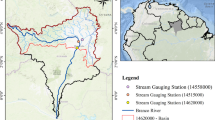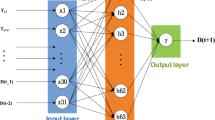Abstract
One of the actions to mitigate the impacts of hydrological extremes is to issue warnings as far in advance as possible. This article reports the application of neural networks for water level forecast to three small watersheds in Brazil that are susceptible to flash floods. First, the physical characteristics and land use and cover maps of the watersheds were surveyed. Next, Multilayer Perceptrons were trained with observed water level and rainfall data covering the period 2014 to 2022 to make water level forecasts 1, 2 and 3 h in advance. To design the neural networks, different combinations of activation functions in the hidden and output layers were tested and also variations in the number of neurons in the hidden layer. The neural networks forecasts for the three watersheds test data were quite good for the three forecast horizons, highlighting the forecasts 3 h in advance that reached a Nash–Sutcliffe index greater than 0.9. In future work, neural networks will be trained with rainfall estimates obtained from numerical weather forecast models data and observed rainfall data, enabling their operational use in the National Center for Monitoring and Early Warning of Natural Disasters situation room. The operational neural models can semi-automate the flash flood warning process for the studied watersheds. As a result, the warnings effectiveness, concerning the advance-assertiveness trade-off, is expected to improve.











Similar content being viewed by others
Data availability
Free access to the data used in this study can be obtained by contacting corresponding author Glauston R. T. de Lima (glauston.lima@cemaden.gov.br).
References
Abrahart RJ, Anctil F, Coulibaly P, Dawson CW, Mount NJ, See LM, Shamseldin AY, Solomatine DP, Toth E, Wilby RL (2012) Two decades of anarchy? Emerging themes and outstanding challenges for neural network modelling of surface hydrology. Prog Phys Geogr 36(4):480–513. https://doi.org/10.1177/0309133312444943
Abreu ES, Rosim S, Rennó CD, Oliveira JRF, Jardim AC, Ortiz JDO, Dutra LV (2012) TerraHidro: a distributed hydrological system to delimit large basins. In: Proceedings of the IGARSS, IEEE international. Munich, 546–549
Banco Mundial (2012) Avaliação de perdas e danos: inundações e deslizamentos na Região Serrana do Rio de Janeiro - Janeiro de 2011. Report (in Portuguese). Available at: https://documents1.worldbank.org/curated/en/260891468222895493/pdf/NonAsciiFileName0.pdf
Bottou L, Curtis FE, Nocedal J (2018) Optimization methods for large-scale machine learning. SIAM Rev 60(2):223–311. https://doi.org/10.1137/16M1080173
Bresch DN (2011) Flood Risk in Brazil (full study). Swiss Reinsurance Company Ltd. Available at: https://www.researchgate.net/publication/253327670_Flood_risk_Brazil_full_study
Cesama - Companhia de Saneamento Municipal (2019) Pesquisa Escolar, Rio Paraibuna. https://www.cesama.com.br/pesquisa-escolar/rio-paraibuna. Accessed Sep 27, 2022
Dawson CW, Wilby RL (1998) An artificial neural network approach to rainfall-runoff modelling. Hydrol Sci J 43(1):47–66. https://doi.org/10.1080/02626669809492102
Dawson CW, Wilby RL (2001) Hydrological modelling using artificial neural networks. Prog Phys Geogr 25(1):80–108. https://doi.org/10.1177/030913330102500104
Deparday V, Gevaert CM, Molinario G, Soden R, Balog-Way S (2019) Machine Learning for Disaster Risk Management. World Bank Report. Available at: https://documents1.worldbank.org/curated/en/503591547666118137/pdf/133787-WorldBank-DisasterRiskManagement-Ebook-D6.pdf
Farr TG, Kobrick M (2000) Shuttle Radar Topography Mission produces a wealth of data. EOS Trans Am Geophys Union 81:583–585
Haddad EA, Teixeira E (2015) Economic impacts of natural disasters in megacities: the case of floods in São Paulo, Brazil. Habitat Int 45(2):106–113. https://doi.org/10.1016/j.habitatint.2014.06.023
IGSP - Instituto Geológico do Estado de São Paulo (2014) Mapeamento de riscos associados a escorregamentos, inundações, erosão e solapamento de margens e drenagens, (II) - Introdução, Metodologia, caracterização do município, Resultado do Risco regional (Technical Report, 108 p.). São Paulo
INMET – Instituto Nacional de Meteorologia (2022a) Dados Históricos Anuais 2010–2021. https://portal.inmet.gov.br/dadoshistoricos . Accessed Aug 15, 2022
INMET – Instituto Nacional de Meteorologia (2022b) Normais Climatológicas do Brasil 1981–2010. https://portal.inmet.gov.br/normais. Accessed Aug 15, 2022
IPCC (2021) Climate Change 2021: The physical science basis contribution of working group I to the sixth assessment report of the intergovernmental panel on climate change. Cambridge University Press, Cambridge
Kobiyama M, Goerl RF (2007) Quantitative method to distinguish flood and flash flood as disasters. Hydrol Res Lett 1:11–14. https://doi.org/10.3178/suisui.1.11
Köppen, W (1918) Climatologia: con un estudio de los climas de la tierra. Mexico-DF: Fondo de Cultura Economica
Lamsal R, Kumar TVV (2020) Artificial Intelligence and Early Warning Systems. In: Kumar TVV, Sud K (eds) AI and Robotics in Disaster Studies. Disaster Research and Management Series on the Global South. Palgrave Macmillan, Singapore. https://doi.org/10.1007/978-981-15-4291-6_2
Lima GRT, Scofield GB (2017) A machine learning based-model to improve short forecasts of flooding in Nova Friburgo-RJ. Revista Brasileira de Cartografia 69(1). https://doi.org/10.14393/rbcv69n1-44030
Lima GRT, Scofield GB (2021) Feasibility study on the operational use of neural networks in a flash flood early warning system. RBRH 26(4). https://doi.org/10.1590/2318-0331.262120200152
Lima GRT, Santos LBL, Carvalho TJ, Carvalho AR, Cortivo FD, Scofield GB, Negri RG (2016) An operational dynamical neuro-forecasting model for hydrological disasters. Model Earth Syst Environ, 2(94). https://doi.org/10.1007/s40808-016-0145-3
Linardos V, Drakaki M, Tzionas P, Karnavas YL (2022) Machine Learning in Disaster Management: Recent Developments in Methods and Applications. Mach Learn Knowl Extr 4:446–473. https://doi.org/10.3390/make4020020
Maier HR, Dandy GC (2000) Neural networks for the prediction and forecasting of water resources variables: a review of modelling issues and applications. Environ Model Softw 15(1):101–124
Mapbiomas (2020) Mural Maps. https://mapbiomas.org/en/mapa-mural?cama_set_language=en. Accessed Dec 21, 2021
Moon SH, Kim YH, Lee YH, Moon BR (2019) Application of machine learning to an early warning system for very short-term heavy rainfall. J Hydrol 568:1042–1054. https://doi.org/10.1016/j.jhydrol.2018.11.060
Moraes OLL (2023) An impact-based forecast system developed for hydrometeorological hazards. Int J Disaster Risk Reduction, 93(103803). https://doi.org/10.1016/j.ijdrr.2023.103803
Mosavi A, Ozturk P, Chau KW (2018) Flood prediction using machine learning models-literature review. Water 10(11):1536–1575. https://doi.org/10.3390/w10111536
Muñoz P, Orellana-Alvear J, Bendix J, Feyen J, Célleri R (2021) Flood Early Warning Systems Using Machine Learning Techniques: The Case of the Tomebamba Catchment at the Southern Andes of Ecuador. Hydrology 8:183. https://doi.org/10.3390/hydrology8040183
Nascimento N, Machado LM, Baptista M, Silva AP (2007) The assessment of damage caused by floods in the Brazilian context. Urban Water J 4(3):195–210. https://doi.org/10.1080/15730620701466591
Oyebode O, Stretch D (2019) Neural network modeling of hydrological systems: a review of implementation techniques. Nat Resour Model 32(1):e12189. https://doi.org/10.1111/nrm.12189
Robbins H, Monro S (1951) A stochastic approximation method. Ann Math Stat 22(3):400–407. https://doi.org/10.1214/aoms/1177729586
Rosim S, Oliveira JRF, Jardim AC, Namikawa LM, Rennó CD (2013) TerraHidro: A Distributed Hydrology Modelling System With High Quality Drainage Extraction. In Proceedings of the GeoProcessing, Nice, 5, 161–167
Roy JK, Gupta D, Goswami S (2012) An improved flood warning system using WSN and Artificial Neural Network. In Annual IEEE India Conference (INDICON) (pp. 770–774). New York: IEEE. https://doi.org/10.1109/INDCON.2012.6420720
Rumelhart DE, Hinton GE, Williams RJ (1986) Learning representations by back-propagating errors. Nature 323(6088):533–536. https://doi.org/10.1038/323533a0
Santos LBL, Freitas CP, Bacelar L, Soares JAJP, Diniz MM, Lima GRT, Stephany S (2023) A Neural Network-Based Hydrological Model for Very High-Resolution Forecasting Using Weather Radar Data. Eng 4(3):1787–1796. https://doi.org/10.3390/eng4030101
Schröter K, Ostrowski M, Velasco-Forero C, Sempere-Torres D, Nachtnebel HP, Kahl B, Beyene M, Rubin C, Gocht M (2008) Effectiveness and Efficiency of Early Warning Systems for Flash-Floods (EWASE). CRUE Final Research Report n 5. https://www.researchgate.net/publication/255947664. Accessed in Aug 10, 2022.
Sedurb-Secretaria de Saneamento, Habitação e Desenvolvimento Urbano-ES (2013) Plano Diretor de Águas Pluviais e Fluviais do Município de Alegre – Volume I: Diagnóstico e Prognóstico de Inundações. https://sedurb.es.gov.br/Media/sedurb/Importacao/Redu%C3%A7%C3%A3o%20de%20risco/Alegre/Volume%20I%20Diagn%C3%B3stico%20e%20Progn%C3%B3stico%20de%20Inunda%C3%A7%C3%B5es.pdf. Accessed in Sep 27, 2022.
Srivastava S, Anand N, Sharma S, Dhar S, Sinha LK (2020) Monthly Rainfall Prediction Using Various Machine Learning Algorithms for Early Warning of Landslide Occurrence. In Proceedings of IEEE 2020 International Conference for Emerging Technology, 1–7
Tanty R, Desmukh TS (2015) Application of artificial neural network in hydrology - A review. Int. J. Eng. Technol. Res. 4(6) 184–188. https://www.ijert.org/research/application-of-artificial-neural-network-in-hydrology-a-review-IJERTV4IS060247.pdf. Accessed in Aug 10, 2022
Thirugnanam H, Ramesh MV, Rangan VP (2020) Enhancing the reliability of landslide early warning systems by machine learning. Landslides 17:2231–2246. https://doi.org/10.1007/s10346-020-01453-z
Vallejos BA, Wirz A et al (2022) Diagnóstico das inundações na bacia hidrográfica do córrego Humaitá-Juiz de Fora e possíveis impactos de mudanças climáticas. I Simpósio Nacional de Mecânica dos Fluídos e Hidráulica, Ouro Preto. Anais ABRHidro. https://anais.abrhidro.org.br/job.php?Job=13913. Accessed in Sep 27, 2022
World Meteorological Organization-WMO (2022) Bulletin nº: v 71 (1). https://public.wmo.int/en/resources/bulletin/artificial-intelligence-disaster-risk-reduction-opportunities-challenges-and. Accessed in Feb 03, 2023
Zucherato B, Cunha L, Freitas, MIC (2016) Análise das áreas de Inundação de Campos do Jordão – SP: caracterização por meio de bancos de dados. In Nunes A, Moreira CO, Paiva IR, Cunha LS (Eds.), Territórios de água (pp. 162–170). Coimbra: CEGOT
Acknowledgements
Author Luiz Ferreira de Aguiar Filho thanks CNPq (National Council for Scientific and Technological Development of Brazil) for grant 800108/2022-1.
Funding
The authors declare that no funds, grants, or other support were received during the preparation of this manuscript.
Author information
Authors and Affiliations
Contributions
G. R. T. L. wrote and reviewed the various versions of the paper; set up the databases; supervised the implementation of the experiments carried out with the neural networks; did the literature review.
R. O. C. collaboratted in the elaboration of relief and land use and cover maps; database organization; collaborated in the revision of various versions of the paper.
L. F. A. F. collaboratted in the elaboration of relief and land use and cover maps; collaborated in the implementation of the experiments carried out with the neural networks.
Corresponding author
Ethics declarations
Competing interests
The authors declare no competing interests.
Additional information
Communicated by: H. Babaie
Publisher's Note
Springer Nature remains neutral with regard to jurisdictional claims in published maps and institutional affiliations.
Rights and permissions
Springer Nature or its licensor (e.g. a society or other partner) holds exclusive rights to this article under a publishing agreement with the author(s) or other rightsholder(s); author self-archiving of the accepted manuscript version of this article is solely governed by the terms of such publishing agreement and applicable law.
About this article
Cite this article
de Lima, G.R.T., de Oliveira Caran, R. & de Aguiar Filho, L.F. Use of neural network as a support tool in water level forecasting and issuing flash floods early warnings to three small Brazilian urban watersheds. Earth Sci Inform 16, 4313–4326 (2023). https://doi.org/10.1007/s12145-023-01159-5
Received:
Accepted:
Published:
Issue Date:
DOI: https://doi.org/10.1007/s12145-023-01159-5




